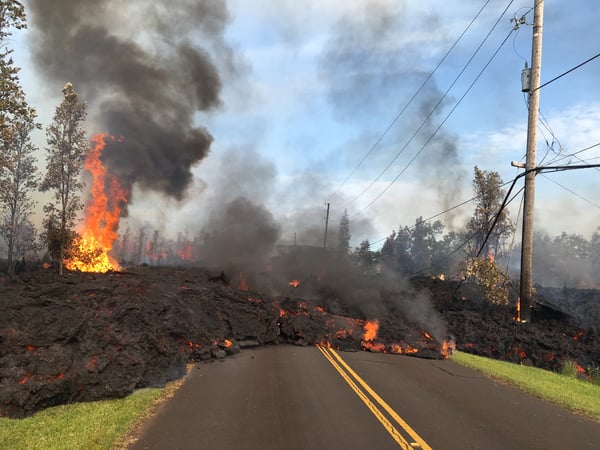We’ve seen the frightening images of glowing, molten lava making its way across homes, yards, cemeteries, schools, and neighborhood streets as the Kilauea volcano wreaks havoc and disaster in Hawaii. In this Shop Talk blog post, we are going to consider the effects of lava on roads and look at how heavy equipment is used in the resulting clean-up process.

Here are a few more related blog posts you might find interesting ...
- Excavating Deep Underwater
- Caring for Your Equipment After a Flood
- Monster Bulldozers by the Numbers
Disaster Area
The Governor of Hawaii, David Ige, successfully requested that Hawaii be deemed a disaster area. Federal funds will go toward the restoration of roads and public buildings damaged as a result of the volcanic activity. In addition, funding will also be used to repair/replace public infrastructure such as water and sewer pipes that have been destroyed. This destruction includes cell phone towers and power lines, too. The exact extent of the damage to Hawaii will not be known right away.
Combine flowing lava with earthquakes, tremors, ash, sulfur dioxide and methane gas, hydrochloric acid, and ballistic blocks weighing in the tons being spewed from the Kilauea volcano, and you have a disaster movie come to life. Just considering the fact that the area experienced 500 quakes in a 24-hour period is not hopeful.
Dealing with Solidified Lava
Starting late last week, CAT bulldozers began ripping up the older, solidified lava along Chain of Craters-Kalpana Road in Hawaii. This process will be followed by rough grading to prepare an evacuation route. Heavy equipment is needed to break up the hardened lava, as shown in the video below where Caterpillar D10 bulldozers are being used to rip up the solid lava.
Along the path of destruction, there will be many areas where hardened lava will need to be removed. Fortunately, solid lava takes the form of relatively soft basaltic rock.
Back in 2015, full-size excavators equipped with hydraulic breakers were used to break up volcanic rock to be hauled away after lava made its way through a trash transfer station in Hilo, Hawaii. Similar efforts will again be required to remove solidified lava. Contractors hired to remove the lava must wait until it cools sufficiently, and it can take months or even years for the lava to harden completely. In Hawaii right now, the lava has reached depths of up to 20’ in some places, which extends the wait time and can complicate its removal.

By United States Geological Survey [Public domain], via Wikimedia Commons
Lava and Roads
Besides the obvious problems of lava solidifying on roadways, there are other issues. According to Ferrovial.com, roadways can collapse, and pockets of air or gases trapped beneath the roadways can cause problems later on. New roads may be built on top of the solidified lava, in which case aggregate is spread on the lava while it is still solidifying. That is not always a feasible solution, however.
Conclusion
Bulldozers, excavators, and dump trucks are all going to be a significant part of Hawaii’s cleanup and recovery. This is especially true for roads that have been affected by the volcano.
Texas Final Drive is your partner in providing new or remanufactured final drive hydraulic motors from a single mini-excavator to a fleet of heavy equipment. Call today so we can find the right final drive or hydraulic component for you, or check out our online store to find your O.E.M. manufacturer brand motor now.


